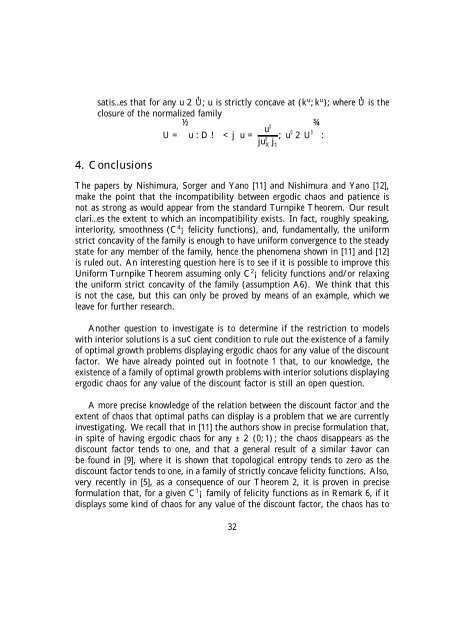Create successful ePaper yourself
Turn your PDF publications into a flip-book with our unique Google optimized e-Paper software.
satis…es that for anyu2 U;uis ¹ strictly concave at(k u ;k u ); where U ¹ is the<br />
closure of the normalized family<br />
¾<br />
U =<br />
½u:D! < j u= u0<br />
ju 0 X j ; u 0 2U 0 :<br />
1<br />
4. Conclusions<br />
The papers by Nishimura, Sorger and Yano [11] and Nishimura and Yano [12],<br />
make the point that the incompatibility between ergodic chaos and patience is<br />
not as strong as would appear from the standard Turnpike Theorem. Our result<br />
clari…es the extent to which an incompatibility exists. In fact, roughly speaking,<br />
interiority, smoothness (C 4 ¡felicity functions), and, fundamentally, the uniform<br />
strict concavity of the family is enough to have uniform convergence to the steady<br />
state for any member of the family, hence the phenomena shown in [11] and [12]<br />
is ruled out. An interesting question here is to see if it is possible to improve this<br />
Uniform Turnpike Theorem assuming onlyC 2 ¡felicity functions and/or relaxing<br />
the uniform strict concavity of the family (assumption A6). We think that this<br />
is not the case, but this can only be proved by means of an example, which we<br />
leave for further research.<br />
Another question to investigate is to determine if the restriction to models<br />
with interior solutions is a su¢cient condition to rule out the existence of a family<br />
of optimal growth problems displaying ergodic chaos for any value of the discount<br />
factor. We have already pointed out in footnote 1 that, to our knowledge, the<br />
existence of a family of optimal growth problems with interior solutions displaying<br />
ergodic chaos for any value of the discount factor is still an open question.<br />
A more precise knowledge of the relation between the discount factor and the<br />
extent of chaos that optimal paths can display is a problem that we are currently<br />
investigating. We recall that in [11] the authors show in precise formulation that,<br />
in spite of having ergodic chaos for any ± 2 (0;1); the chaos disappears as the<br />
discount factor tends to one, and that a general result of a similar ‡avor can<br />
be found in [9], where it is shown that topological entropy tends to zero as the<br />
discount factor tends to one, in a family of strictly concave felicity functions. Also,<br />
very recently in [5], as a consequence of our Theorem 2, it is proven in precise<br />
formulation that, for a givenC 1 ¡family of felicity functions as in Remark 6, if it<br />
displays some kind of chaos for any value of the discount factor, the chaos has to<br />
32

















